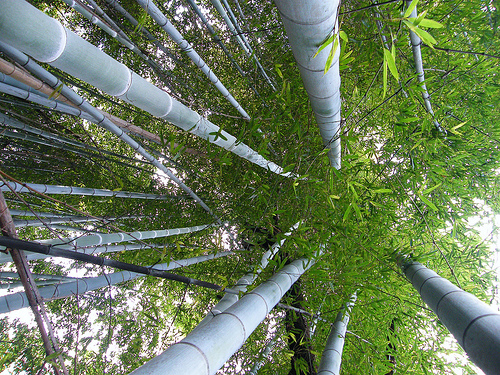One downside to bamboo comes during the production process. Since the plant itself isn’t fibrous, it’s mashed down into sort of a chemical slurry and then pressed into fabric. The process is similar to making rayon. It’s toxic for workers, and it strips the bamboo of its beneficial antimicrobial properties. There’s also the trouble that comes with anything that gets popular. Despite its speedy growth, there is still a threat of overharvesting bamboo. According to the U.N., around 600 varieties of bamboo are extinct or threatened. Wait…that doesn’t sound fab at all! Well, Greenyarn, a new Boston-based company, has a new approach to producing bamboo fabric that’s worth a look! Rather than the scary chemical mush process, Greenyarn produces its Eco-Fabric using “bamboo charcoal,” which is made by heating the bamboo in a kiln. Here’s how the process works: The resulting bamboo charcoal retains the plant’s natural antifungal and antibacterial properties. Third stage carbonization: the temperature is in the range of 260℃ to 450℃, and the bamboo is decomposed into liquid and gas products. Liquid products contain much acetic acid, methanol and bamboo tar. Flammable methane and ethylene in gas products are increasing while carbon dioxide production is reduced. Fourth stage calcinations (refining stage): the temperature is over 450℃. The bamboo is becomes charcoal by means of providing a mass of heat, emitting the volatile substances and to enhance non-volatile carbon. Based on the temperature in this stage, the bamboo charcoal can be divided into three groups (low-temperature, middle-temperature and high-temperature charcoal). The quality and properties of bamboo charcoal differs with different temperatures during the refining stage. I’ve got a few concerns about this process, though it does sound better than the conventional methods. They don’t mention how they deal with the CO2, carbon monoxide, or methane by products that they mention. Also, with so much heat, you’ve got to wonder how much energy it takes to produce the charcoal. They don’t get very specific about what happens between making the charcoal and the “nano particles.” According to their site, “Bamboo charcoal is sent for further processing and made into fine nano particles.” That could really mean anything. From the pictures, it looks like they’ve ground the charcoal down into a finer powder, but looks can be misleading. They mention specifically that they use moso bamboo, which grows at high altitudes in the mountains of Taiwan. It regrows in about five years. I couldn’t find any information on whether moso is one of the threatened bamboo species. I do really like Greenyarn’s mission statement: “Greenyarn strives to produce revolutionary products using environmentally friendly process and materials.” It gives me a little hope that the mystery process between charcoal and the nano particles for spinning might not be problematic. They also say that they “do not support industry harmful to the environment, and manufacturing process are sustainable. We work with certified and reputable factories to manufacture products that are safe and consistent in quality.” So what do you guys think? Does Greenyarn Eco-Fabric sound like a better bamboo fabric? If you want to give Greenyarn a whirl, they have a list of retailers on their website. Image Credits: Bamboo Charcoal. Creative Commons photo by suajack Bamboo. Creative Commons photo by emrank via Detroit Arts and Crafts Examiner

